#rhamnus lanceolata
Photo


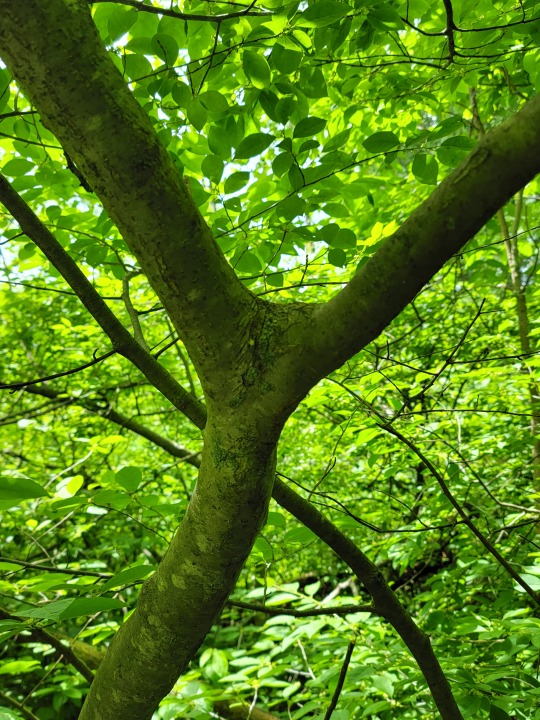
Lance leaf Buckthorn,
Rhamnus lanceolata
Bring this plant back, make it common, make it known for fall interest, make it known for it’s benefits and scale and structure.
A show stopper, an under utilized native that can thrive in rocky conditions and specifically does well in alkaline hillsides, at one point Cincinnati Ohio was known for having this species in such high abundance that it was considered a weed species. I wish that was still the case, now Cincinnati is honey suckle and other suitable habitat is invasive buckthorn, privot, and autumn olive. This is a critical nectar species during transition from spring to summer, a bee and wasp magnet. Here we see it in alkaline uplifted marl and till located along risen sections of the black ash white cedar swamp woodland of cedar bog(a fen).
This species was also an incredible thicket island species critical to prairies and I never see it in restoration or recreation plots.
https://indigescapes.com/blog/2019/7/25/the-myth-of-the-thicket-less-prairie
#botany#plantblr#rhamnus#rhamnus lanceolata#cedarbog#ohio#wildflowers#prairie#meadow#meadowcore#cottagecore#plants#wildflower#horticulture#bees#savethebees#you know native bees#save the natives
53 notes
·
View notes
Text
Come sconfiggere la costipazione con soluzioni efficaci e naturali

Nel ritmo frenetico della vita moderna, la costipazione può emergere come una sfida quotidiana che mina il benessere generale.
Il disagio derivante da movimenti intestinali irregolari e difficoltà nell’evacuazione può influenzare la qualità della vita in modo significativo.
Questo articolo si prefigge di immergersi in modo più approfondito nel complesso mondo della stitichezza, esaminando come sconfiggere la costipazione con soluzioni efficaci e naturali.
Le complesse cause della costipazione
La stitichezza (o stipsi) è un comune disturbo gastrointestinale che colpisce oltre 10 milioni di italiani.
Questo problema è più diffuso tra le donne, gli anziani oltre i 65 anni e può anche manifestarsi durante la gravidanza, dopo il parto o dopo interventi chirurgici.
La stitichezza è caratterizzata dalla difficoltà di evacuare l’intestino e di espellere le feci. Normalmente, si considera che una frequenza di almeno 3 evacuazioni alla settimana sia fisiologica.
Questo disturbo riflette una serie di fattori, tra cui una dieta carente di fibre, che può ridurre il movimento intestinale, provocando feci secche; la mancanza di idratazione, poiché l’acqua è essenziale per mantenere la morbidezza delle feci; uno stile di vita sedentario, dato che può rallentare il ritmo intestinale; le fluttuazioni ormonali, come quelle verificatesi durante la gravidanza, che possono influenzare la regolarità intestinale; e, infine, la presenza di farmaci come antidolorifici e antidepressivi, possono generare costipazione come effetto collaterale.
Strategie naturali per sconfiggere la costipazione
Esistono una serie di piante per il trattamento della costipazione: il Lino, il Psillio, la Cascara Sagrada e molte altre.
Il Lino (Linum usitatissimum) è una erbacea annuale che ha diverse utilità nella produzione di fibre e di olio. I suoi fiori sono generalmente azzurri, raramente bianchi o rosa. Sono caratterizzati da un delicato colore e si aprono solo se esposti alla luce.
Le foglie sono alterne, strette e hanno una forma lineare o lanceolata. Sono percorse da tre nervature principali. Il frutto è una capsula globosa che contiene 10 logge, o compartimenti, ognuno contenente un singolo seme.
Il lino è probabilmente originario del Caucaso ed è diffuso in Europa meridionale. Nella pianta, la parte utilizzata per le sue proprietà è il fusto, che viene coltivato per le fibre, o i semi, utilizzati per l’estrazione dell’olio.
Gli oli di semi di lino sono ricchi di acidi grassi essenziali e vengono utilizzati sia a scopo alimentare che cosmetico.
Il Psillio (Plantago psyllium) appartiene alla famiglia Plantaginaceae. Le foglie sono strette e lunghe, con una curvatura verso il basso. I fiori sono di colore bianco e si presentano in spighe numerose e cilindriche.
I frutti sono capsule che, quando maturano, rilasciano i semi. Questi sono piccoli, lunghi circa 2-3 mm, con una superficie liscia e lucente. Sono di colore bruno e hanno un’area più chiara sulla superficie convessa. Sono coperti da un rivestimento mucillaginoso.
Originario dell’area mediterranea, il psillio è coltivato anche in India e Iran. La parte della pianta utilizzata per le sue proprietà è rappresentata dai semi, che contengono una mucillagine composta da xilosio, arabinosio ed acido galatturonico. Il psillio è noto per le sue proprietà emollienti e come lassativo meccanico.
Assunto con abbondanti liquidi, aumenta il contenuto intestinale e lubrifica le pareti intestinali, stimolando la peristalsi. È consigliato nei casi di stitichezza abituale, colon irritabile e nei casi di potenziale allergia.
La Cascara Sagrada (Rhamnus purshiana) appartiene alla famiglia Rhamnaceae. Parliamo di un arbusto che può raggiungere un’altezza compresa tra 6 e 12 metri. Ha un tronco rugoso, brunastro, e rami con una corteccia bianco-grigiastra e liscia. Le foglie sono disposte in modo alterno, ovali e picciolate.
I fiori sono di piccole dimensioni, di colore bianco. Il frutto è una piccola drupa ovoidale, che diventa nerastra quando è maturo. Inoltre, è triloculare, cioè composto da tre logge. Questa pianta nasce sulla costa pacifica del Cile, degli Stati Uniti (dove è coltivata) e del Canada.
È coltivata anche in Europa e in Kenya, ed è nota anche come “corteccia santa”. La parte della pianta utilizzata per le sue proprietà è la corteccia. Questa pianta è conosciuta per le sue proprietà lassative e viene spesso utilizzata per promuovere la regolarità intestinale.
Approcci preventivi e strategie di gestione
Dieta equilibrata: un’alimentazione variegata ed equilibrata, ricca di fibre e sostanze nutrienti, fornisce al sistema digestivo gli strumenti necessari per funzionare ottimamente.
Monitorare i farmaci: se l’assunzione di farmaci provoca costipazione, il dialogo con un medico può aiutare a valutare soluzioni alternative o a pianificare un approccio più efficace.
Gestione dello stress: l’equilibrio psico-fisico è fondamentale. La pratica di tecniche di rilassamento, come la meditazione o il respirare consapevole, può migliorare la funzionalità intestinale.
Quando consultare un medico
La costipazione, sebbene spesso venga considerata come un fastidio minore, può avere un impatto notevole sulla qualità della vita.
L’approccio naturale e la gestione olistica attraverso un’alimentazione sana, l’attività fisica e la cura delle abitudini quotidiane possono contribuire a prevenirla e affrontarla con successo.
Tuttavia, la chiave per il benessere duraturo risiede nel monitoraggio dei sintomi e nella consultazione con professionisti medici quando necessario. Un sistema digestivo in salute è un fondamento per un corpo sano e vitale.
Se sei alla ricerca di ulteriori risorse su come sconfiggere la costipazione con soluzioni efficaci e naturali, ti consiglio di esplorare le opzioni offerte da Mednews.
Con una vasta gamma di articoli informativi, consigli pratici e risorse utili, l’azienda si impegna a fornire informazioni accurate e aggiornate per affrontare al meglio le sfide legate alla salute intestinale.
Read the full article
0 notes
Photo







Rhamnus lanceolata

species that often was associated with alkaline dry hillsides, open talus hillsides, and has it’s core in the barren sections of the Ozarks but does well in barren sections in the ILP as well. It was at one point an incredibly common species before amur honeysuckle and heartstopper buckthorn. Now, in Ohio we see it rarely, even less so than the niche companion Dr. Lucy Braun’s field notes on it mentioned, which is Rhus aromatica.
Late June is when this species is in bloom, an incredible nectar source.
I wish nurseries would give us the option of this plant because of this.
I included a stem shot of spice bush and lance leaf buckthorn because of the lenticel patterns often having over lap and they both form understory thicket often along the same forested hillsides, crack the leaves if your not sure, spice bush is very aromatic.
Aside from that, I would like more people to report this species via I naturalist when they find it if they are in east coast states, the south, or the ILP where it is uncommon or rare.
16 notes
·
View notes
Photo

Went to Pearls with Dan Boone a while back and was told about some interesting issues about a few thicket species( american plums that could potentially have less flux and die off as a result with more fire) and this small population; along the seep stream there is a small remnant Ramnus lanceolata(sparse but there are red leaves in this photo, it’s fall, frogs and cran...) population, there is low recruitment now with only 4 members and 3 old growth individuals. With some time and proper management including fire, we may see more in time. While Ramnus lanceolata may seem too small to take fire, they are fairly adapted to it. While im not necessarily sure of the ecological concepts behind these adaptations, many thicket species are capable of coming back from the roots as suckers or from modified psuedo-caudex burl like structures like lignotuber, a specialized organ that the genera Rhamnus is known to have; with that said, i’ve never looked at herbarium specimens of the root system of Rhamnus lanceolata, only leaves, flowers, and fruits. I have found no literature supporting that this specific species can occur with lignotubers. Lucy Braun (Dr. E. L. Braun) had described populations in Ohio a few times growing on open calcium rich slopes with Rhus aromatica, in hillside thickets near hillside prairies. Fallen prairie in Adams co. is a barren containing Carolina buckthorn and lanceleaf buckthorn in-situ * specific Braun field notes are in Lloyd library if you get a chance* , these barrens require fire for their health. In one paper about Kansas plant communities there seems to be descriptions of thicket habitat being semi-riparian,
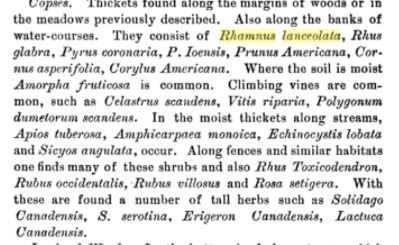
^from Ecological Plant Geography of Kansas.
https://www.jstor.org/stable/2420211?seq=1#metadata_info_tab_contents
^ also, among learning a while back that we at one point had sandstone in cincinnati, I’ve also learned that at one point 6 miles north of cincinnati was Este’s bog, that seemed like it could of been a pretty nice place.
3 notes
·
View notes
Photo

Viburnum rufidulum
Southern Rusty Black Haw Vibernum
William @theancient2 and I thought we found the third native species of Buckthorn (an alternate leaved species that has close alternation) Not the case with this opposite branching pattern in hindsight and a known lower thicket growth pattern. Still some interesting concepts have come up after realizing that Southern Rusty Black Haw was at Lynx and I learned another example of range expansion included species.

Photo from Maryland state archive
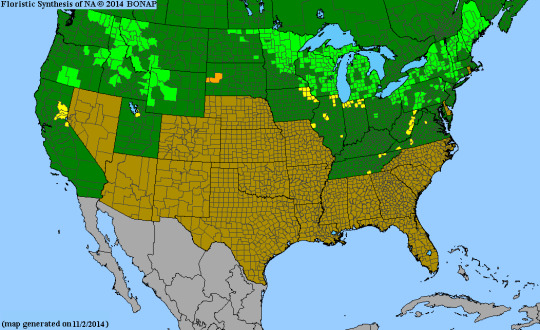
Rhamnus alnifolia at first glance may look opposite but its closely alternate and may even have some depauperate branching patterns, R. cathardica(invasive) is known to do this too which can make eyeballing these species without flowers a wild ride.
as for ohio and range constraints.
R. alnifolia, is considered a Northern Appalachian disjunct and Boreal matrix from the Wisconsin front species, often found in karst exposure in Greene co dolomite refugium. Fort Hill in highland county was known for it, not the case however at Lynx in Adams from the post Arkansas semi xeric southern expansion.
Rhamnus lanceolata, is a species considered an Ozark core species theorized to have come in from the most recent semi xeric interval. (photo from mobot)

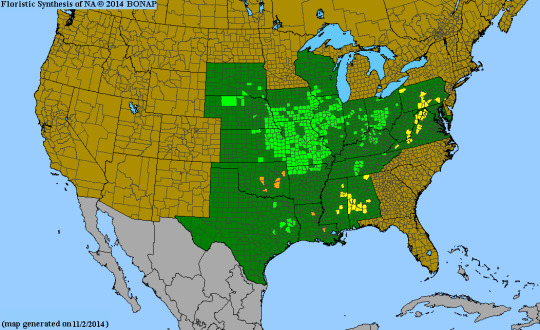
and Frangula caroliniana , southern expansion is what was theorized from some time post Arkansas glaciation.
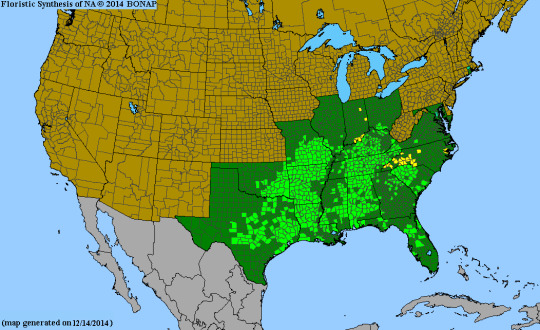

Photo from William Cook

All of these are also known from Adams by record, some considered extant and one locally extirpated though all of these were brought in from different intervals of range expansion.
As for this opposite leaved Viburnum rufidulum; it follows the same expansion pattern as Frangula caroliniana and makes sense why it’s in a place in Adam’s county with more southern distributed core species instead of R. alnifolia which is associated with Wisconsin glacial refugium sites that have stuff like Taxus canadense but not truly associated with Sullivant’s Cool Wort.
#Viburnum rufidulum#viburnum#wildflowers#plantblr#ohio#range dist#distribution#floral distribution in environment#ecology
583 notes
·
View notes